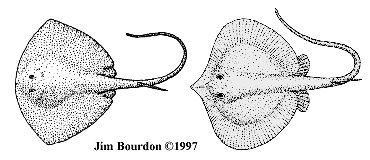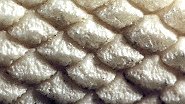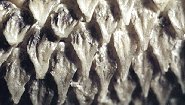| |

Extant members of this family are represented by nearly 70 described species spanning
six genera. Most commonly, these rays frequent shallow tropical and subtropical waters
worldwide. However, depending on species, these rays may inhabit freshwater rivers &
lakes or lead a pelagic life-style. In bottom dwellers, the pectorals may be used to
excavate for worms, mollusks, crustaceans, Fish and cephalopods are included in the diet
of some species.
 |
Fig. 1 Left - Pteroplatytrygon violacea
Right - Dasyatis sabina |
Dasyatids have an enlarged pectoral disk, circular to rhomboid in shape with a rounded
or angular snout. The flattened body lacks a dorsal fin, and may be naked or bear
denticles/thorns. The mouth is small and subterminal, the spiracles located close behind
the eyes and the pelvic fins are singled-lobed. The tail is longer than the disk (often
greatly elongated) and whip-like posterior to the stinger. Depending on the genus there
may or may not be dorsal and/or ventral longitudinal caudal folds. More than one of the
barbed and venomous caudal spines may be present.
Compagno (1999) included six genera:
- Dasyatis RAFINESQUE, 1810 -- Fintail Stingrays -- 39
plus 5 undescribed species. Represented circumglobally in temperate and tropical seas,
from nearshore to uppermost continental slope. Also known from warm-temperate &
tropical lakes & rivers.
- Himantura MÜLLER & HENLE, 1837 -- Whip rays -- 23
described plus 4 undescribed species. A tropical Indo-Pacific genus of continental &
insular shelves, it is also found in the Western Atlantic & eastern Pacific and may
inhabit rivers & lakes.
- Pastinachus RÜPPELL, 1829 -- Feathertail stingrays --
Represented by a single species [placed by some authors in in Hypolophus or
Dasyatis], these rays are known from tropical Indo-West Pacific continental
shelves, rivers & lakes.
- Pteroplatytrygon FOWLER, 1910 -- Pelagic Stingray --
P. violacea (traditionally deemed Dasyatis) is the only species
ascribed to this genus. It is found circumglobally in tropical and temperate seas.
- Taeniura MÜLLER & HENLE, 1837 -- Ribbontail stingrays
-- The three species included in this genus are reported from tropical-temperate
continental & insular shelves of the Eastern Atlantic & Indo-Pacific.
- Urogymnus MÜLLER & HENLE, 1837 -- Porcupine rays --
Lacking tail spines, the two species of this tropical genus can be found in
rivers & lakes of West Africa and the continental shelves of the Eastern Atlantic
& Indo-Pacific Oceans.
 The dasyatid dentition is made up of numerous (100s per jaw) small, closely packed teeth,
typically serving a crushing function in females and crushing-grasping in males. In both
designs the posterior teeth are low-crowned and labio-lingually compressed. It's the
anterior teeth that reflect the greatest difference between the two designs -- being
high-cusped in the grasping/clutching dentition and rather globular in the crushing.
Lateral teeth tend to be transitional between their posterior and anterior counterparts.
The anteriors are the largest teeth in the lower jaw and laterals, the largest in the
upper.
The dasyatid dentition is made up of numerous (100s per jaw) small, closely packed teeth,
typically serving a crushing function in females and crushing-grasping in males. In both
designs the posterior teeth are low-crowned and labio-lingually compressed. It's the
anterior teeth that reflect the greatest difference between the two designs -- being
high-cusped in the grasping/clutching dentition and rather globular in the crushing.
Lateral teeth tend to be transitional between their posterior and anterior counterparts.
The anteriors are the largest teeth in the lower jaw and laterals, the largest in the
upper.
 |
 |
 |
Fig. 2 Top - Dasyatis centroura, female, NMNH #111,129
Left - D. say, female lower, NMNH #110,229
Right - D. americana, male lower, NMNH #232,720 |
The sexual dimorphism suggested by these high/low-cusped comments is far from universal.
In Dasyatis sabina both sexes have low-crowned
teeth most of the year, however, the male teeth grow increasing more cuspidate as the
breeding season approaches -- to assist in fin grasping (Kajiura et al 1996).
In Pteroplatytrygon violacea, both males
and females have cuspidate teeth, an apparent advantage for its pelagic life style.
The dasyatid tooth is readily distinguishable from most other batoids. The primary
characteristic are the bilobate roots. The lobes are low, elongated and lingually directed.
They are separated by a wide and deep nutrient groove which usually has a large central
foramen or a group of smaller foramina. The strong slope of the labial margin of the roots
helps distinguish these teeth from other non-dasyatoid families. The crown lacks a distinct
lingual uvula, bears a transverse ridge and when viewed laterally, extends well beyond the
labial face of the root.
Due to the number of variables that can influence tooth design (position, sex, age, season,
etc.) and the large number of (poorly studied) species which must be considered, it is
unlikely that most isolated dasyatid teeth (extant or fossil) can be identified with any
degree of certainty. As samples grow larger, providing insight into the overall dentition
design, some confidence can develop.
|